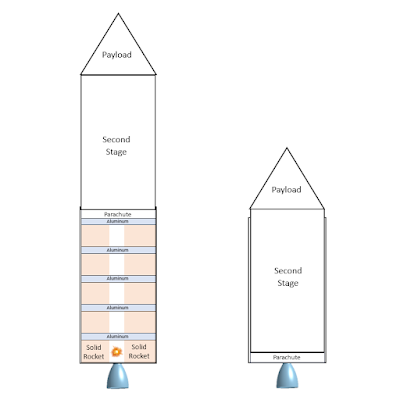Solid Rockets have many cons and pros. I thought about an idea to overcome one of its cons. As the solid propellent burns, the interior volume increases due to void of the consumed propellent. This decreases the interior pressure and the thrust. If the combustion can be kept within a confined space like the combustion chamber of a liquid rocket engine, the specific impulse of the rocket which is its efficiency can be increased.
My idea is to divide the solid propellent into sections. Like shown on the diagram. For aluminum based solid propellants, aluminum separators can be used. These separators keep the combustion on the lowest section of the rocket only. As the lowest section is consumed the weight of the upper stages keeps the combustion area small. With the intense heat generated by the combustion, the separator vaporizes and ignites the immediate upper solid propellent. The thickness of the separator determines the timing of each sections burn time.
The solid rocket boosters have very thick walls because of high pressure inside. With the Sliding Sectioned Solid Rocket design, only the lowest section of the rocket needs thick walls. The rest of the stage can be much thinner while the solid unburned propellent can keep its form unlike the liquid propellants. As a result, the overall weight of the rocket would be reduced and the efficiency is increased.
During stage separation, the outer walls of the first stage would act like a barrel of a cannon which would repel the first stage (slowing it down) and transfer more forward momentum on the second stage compared to traditional rocket designs. The consumed stage would then free fall to earth with parachute attached for recovery and reuse.
Magnesium can be used instead of aluminum as the section separator. Magnesium is lighter, stronger and has lower boiling point than aluminum.

No comments :
Post a Comment